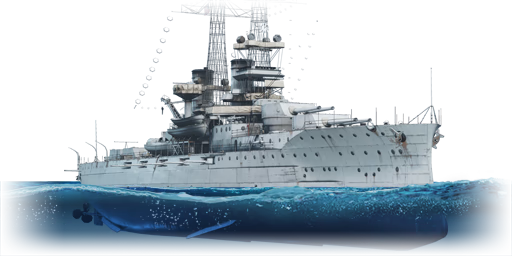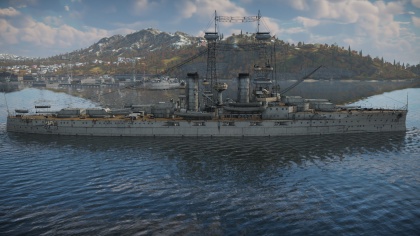USS North Dakota
Contents
Description
The Delaware-class, USS North Dakota (BB-29), 1919 is a rank American battleship
with a battle rating of (AB), (RB), and (SB). It was introduced in Update "New Power".
General info
Survivability and armour
Talk about the vehicle's armour. Note the most well-defended and most vulnerable zones, e.g. the ammo magazine. Evaluate the composition of components and assemblies responsible for movement and manoeuvrability. Evaluate the survivability of the primary and secondary armaments separately. Don't forget to mention the size of the crew, which plays an important role in fleet mechanics. Save tips on preserving survivability for the "Usage in battles" section. If necessary, use a graphical template to show the most well-protected or most vulnerable points in the armour.
Mobility
Write about the ship's mobility. Evaluate its power and manoeuvrability, rudder rerouting speed, stopping speed at full tilt, with its maximum forward and reverse speed.
| Mobility Characteristics | |||
|---|---|---|---|
| Game Mode | Upgrade Status | Maximum Speed (km/h) | |
| Forward | Reverse | ||
| AB | |||
| Upgraded | |||
| RB/SB | |||
| Upgraded | |||
Armament
Primary armament
- 5 x 12-inch/45 Mk.5 cannons
The 12-inch/45 Mk.5 only comes with AP.
Secondary armament
- 14 x 5-inch/45 Mk.5 cannons (7 per side). Comes with Common shells stock and an APC round as a tier I modification.
Anti-aircraft armament
- 2 x 3-inch/50 Mk.10 cannons (1 per side)
Torpedo armament
- 2 x 533 mm Bliss Leavitt Mk.1 Launchers with 6 torpedoes each.
Usage in battles
Your main goal as a battleship (dreadnaught) in Realistic battles that also include "Naval EC" is to fight and control the battlefield with your high-calibre shells, mainly targeting heavy cruisers and battleships, due to lacking any high-explosive shells. It is not advisable to shoot at light cruisers due to your high penetration armour-piercing shells (487 mm at 1 km). Though you still can shoot at them, however, your effectiveness will go down when compared to shooting at heavy cruisers and battleships. These rounds will still do major damage to the interior of the ship. Stay near allies that can be helpful with taking down enemies larger than heavy cruisers. It is recommended not to be part of the main force to push onto the battlefield, your ship is slower compared to the other ships that you will be fighting, and if a fight goes sour you can easily be overrun and defeated by the enemy due to focus firing while trying to retreat to a more advantageous position.
Stay near friendly ships that can support in the anti-air area, this battleship has very poor anti-air defence capabilities and what little anti-aircraft it does receive are 2 x 3-inch guns. A list of ships to stay near during battles, these ships can support you with a volume of different but strong anti-aircraft support. There are other ships that can support your ship but with the size and speed of this ship, the ships you need to stay by either need, long-range anti-aircraft, or mass of shells anti-aircraft. A good list is below:
- USS Sumner (DD-692)
- USS Phelps (DD-360)
- USS Cleveland (CL-55)
- USS Helena (CL-50)
- USS Northampton (CA-26)
- USS New Orleans (CA-32)
- Type 1936A (Mob)
- Leipzig
- Nürnberg
- Prinz Eugen
- Admiral Hipper
- Admiral Graf Spee
- HMS Arethusa
- HMS Hawkins (D86)
- HMNZS Leander
- HMS York (90)
- HMS London (69)
- IJN Tone
- IJN Suzuya
- IJN Mogami
- IJN Mikuma
Modules
| Tier | Seakeeping | Unsinkability | Firepower | ||
|---|---|---|---|---|---|
| I | Dry-Docking | Tool Set | Anti-Air Armament Targeting | 5-Inch APC | |
| II | Rudder Replacement | Fire Protection System | Smokescreen | Auxiliary Armament Targeting | |
| III | Propeller Replacement | Shrapnel Protection | Ventilation | Primary Armament Targeting | Improved Rangefinder |
| IV | Engine Maintenance | New Pumps | Ammo Wetting | ||
Pros and cons
Pros:
- Large calibre shells
- Can take quite a bit of damage
- Comes with torpedoes for additional firepower
Cons:
- Slow
- Lack of anti-aircraft support
- Long reloads
- Lack of high-explosive rounds for the main cannons
- you are a prime target for everyone because you are a battleship and at the highest BR at the moment
History
Devblog
When the British Dreadnought was built, the United States had been completing their own “all-big-guns” battleship, the South Carolina class. Despite the fact that the new ships were not generally inferior to the British competitor, they were criticized for their small hull size and weak auxiliary artillery.
As a result, the Delaware-class battleships were developed during the mid 1900s. Being larger, better armed and more protected than the preceding South Carolinas, the Delaware-class battleships were ordered for construction and laid down in 1907. The two ships of the class, USS Delaware and USS North Dakota, were both commissioned into service with the USN in April 1910. Although sister ships, USS North Dakota featured a different propulsion system than USS Delaware - namely a steam turbine instead of a traditional steam engine.
Both ships saw only limited action, despite serving through the WWI period. While USS Delaware was operating overseas in European waters, USS North Dakota was kept close to the American shoreline due to concerns about its novel propulsion system. Following the end of WWI, both ships mostly continued their peaceful service until the signing of the Washington Naval Treaty in 1922.
Upon the treaty’s signing, the Navy’s strength was limited, particularly in battleships. As a result, both of the Delaware-class battleships were gradually put out of service during the 1920s while newer battleships were built to replace them. USS Delaware was broken up for scrap in 1924, while USS North Dakota eventually met the same fate in 1931, after serving as a target ship for several years.
Media
- USS North Dakota (BB-29) Devblog Images
See also
Links to articles on the War Thunder Wiki that you think will be useful for the reader, for example:
- reference to the series of the ship;
- links to approximate analogues of other nations and research trees.
External links
| Fore River Shipyard | |
|---|---|
| Battleships (BB) | |
| Delaware-class | USS North Dakota |
| Nevada-class | USS Nevada |
| Note | Fore River Shipyard was purchased by Bethlehem Steel Corp. in 1913. |
| USA battleships | |
|---|---|
| Delaware-class | USS North Dakota |
| Wyoming-class | USS Wyoming · USS Arkansas |
| New York-class | USS Texas |
| Nevada-class | USS Nevada |
| Pennsylvania-class | USS Arizona |
| New Mexico-class | USS Mississippi |
| Tennessee-class | USS Tennessee |












